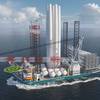Tracking Ship Emissions from Space
A new ground-breaking study by University College London (UCL) Energy Institute, Imperial College and the University of Oxford shows how satellite tracking could be used to monitor compliance with the upcoming IMO 0.5% sulfur emission regulations and Emission Control Areas (ECA).
Research conducted by their own researchers, UCL Energy and the University of Oxford and published today in Geophysical Research Letters, has unveiled discoveries that appear important on many levels for they describe the impact of shipping emissions on the climate: because fossil fuel emission particles from ships affect the air including by releasing sulfur, they affect clouds and consequently the environment.
Acknowledging and investigating the phenomenon "could help scientists to create more accurate climate models, and shipping’s regulators to potentially monitor the sulfur content in emissions from ships".
In addition, satellite tracking has proved worthy of great interest for giving a precious hint about the future impact of restrictions on sulfur in fuels, revealing that "the impact of ships on clouds largely disappears in ECA zones", an "information [that] can be used to build a relationship between cloud properties and the sulfur content of shipping fuels".
It is also stated that emissions released by ships "can change clouds, leaving lines – known as ship tracks – in the clouds behind them as they sail." This means satellite tracking can be used to address the question of the upcoming 0.5 percent limit sulfur emission regulations by helping monitor them and tracking ships that are not compliant.
Lead researcher Dr Edward Gryspeerdt, from the Department of Physics at Imperial College, pointed out: “Ship tracks act like an experiment that would be impossible for us to do otherwise – we cannot inject sulfate aerosols into the atmosphere at such scale to see what happens. Instead, restrictions on the amount of ship sulfate emissions can contain provide us with a perfect experiment for determining just how important the aerosols are in cloud formation. By analyzing a huge dataset of ship tracks observed from satellites, we can see that they largely disappear when restrictions are introduced, demonstrating the strong impact of aerosols.”
As another important consequence, it will now become possible to detect ships that are not compliant by observing and measuring the effects of the high-sulfur fuel burnt without exhaust treatment on the cloud properties captured by satellite.
Regretting that “currently, it is hard for regulators to know what ships are doing in the middle of the ocean", Dr Tristan Smith from UCL Energy Institute explained that: "undetected non-compliance with the 2020 sulfur regulations is a real risk for shipping companies because it can create commercial advantage to those companies who do not comply."
Dr Smith further added: “This study shows that science and technology are producing significant advancements in the transparency of shipping, and helping to reduce risks and unfairness for responsible operators.”
Finally, the press release presenting the study indicated that these promising discoveries will lead to further hopes and measures in the fight against climate change: "As well as exploring how the method could be used to identify ships that may not be in compliance with the 0.5 percent limit, the team now want to more precisely relate known ship fuel compositions to ship tracks, allowing them to more accurately predict the influence of sulfur aerosols on cloud formation on a larger scale, ready to feed into climate models."










